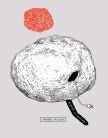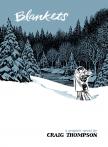Tell It to Me in Pictures
This story really begins with Will Eisner, who grew up poor and Jewish in the 1920s and in pre-War, Depression-era Brooklyn. Eisner published what’s generally considered the first graphic novel, A Contract With God, in 1978. He also coined the term “sequential art”—which helps to explain to some of us how comic books became graphic novels. Eisner taught a course on sequential art for years at the School of Visual Arts in New York City. Before that, in 1940, he wrote a syndicated newspaper comic called “The Spirit,” named for its hero, a resurrected-detective-turned-superhero. Later, he created another character, Mr. Mystic. Eisner continued to tackle big subjects into his 80s in graphic novels like Fagin the Jew, where he expanded the character from Dickens’ Oliver Twist beyond its anti-Semitic stereotypes. The Comic Book Hall of Fame is even named for Will Eisner. So, whether they know it or not, all of these author-artists under review are his grandchildren.
Religion remains a core subject for graphic novelists. There’s a bit of madness to religion, of course, which is part of the appeal, I’m convinced, even in a graphic novel, and even as their readership is skewed toward those under the age of 30. Many graphic novelists seem to be “working out” the ways they’ve been devastated by faith. The genre is good for this, since anger and frustration are easily communicated by the drawings.
Take for instance, the new book by Bunn, Churilla and Stewart, who serve as writer, illustrator, and colorer of Hellbreak. It features episodes of exorcism, complete with the priest-in-collar Father Gabriel Lloyd, but taking place in a dungeon torture chamber. Before priest and possessed make their way there, and Father Lloyd begins to read the rite, they meet in the patient’s bedroom, where he’s chained to the bed. “I’d like to know what opened the door for you. What sin was the catalyst?” asks the priest. The possessed responds, “From the moment you were dragged screaming and bloody from your cow of a mother, you start building damnation brick by brick, and you carry hell around with you for the rest of your days.” There’s the fury, and you can imagine how the drawings of the possessed man’s facial expressions easily turn it into horror.
At the opposite end of the spectrum of faith-disillusionment in graphic novels is Anders Nilsen, born in 1973 in New Hampshire. He uses cross-outs and blot-outs in his cartooning to demonstrate the creative process itself and to make more real his own inner processing. The resulting visual is not at all like the comics you may have grown up reading in the Sunday paper. I grew up in the 1970s purchasing Spider Man, Superman and Archie at 7-Eleven. How interesting the evolution of the genre has been since then. But then how odd that the shelving category for these books is still most often, in libraries and bookstores, “Young Adult (YA)”—as if comic books cum graphic novels are mostly for kids. They aren’t.
Anders Nilsen has his characters thinking about the death of God, even the Protestant Reformation, nihilistically. Poetry Is Useless is a series of musings to demonstrate the thesis of the title. Nilsen is an angry, probably recent, atheist. One of his musings goes like this: “You are a beast, an animal, snuffling in the dirt. This theory you have, that you were formed from the clay by the hand of God, given special attention, your life breathed into you by his very breath: it’s a fiction. You are no different than the insects, the worms, some feral bog. In fact, the very conceit at the heart of your theory debases even this lowly status. No worm thinks it was made in the image of God.” To think that my parents were concerned about my reading Spider Man!
Blankets, meanwhile, is a coming-of-age story set in the American Upper Midwest, and has appealed to thousands of teenagers since it first appeared—all 600 pages of it—in 2003. It’s a memoir told like a novel, with more pictures than text. I read it in three hours, in one sitting. It is David Copperfield with evangelical Christian fear and adolescent self-loathing thrown in. We watch the author Craig Thompson under strict discipline at home, subject to relentless bullying at school, dreaming of running away and hearing at church that nothing about life is scary “if you are a Christian and have asked Jesus into your heart; because when you die, you’ll go to heaven.” He falls in love, lies to his parents and then loses the girl. The comparison to Dickens is apt because Blankets is a romantic book, designed to tug emotionally. More than any of its other qualitues, this is what marks it as aimed at teenagers.
The most powerful piece of new sequential art this year is in The Best American Comics 2015. It’s a short story entitled “Palm Ash” by Julia Gfrorer, and I’m astonished that it made it into such an annual collection. For 16 deeply powerful pages, Gfrorer (also New Hampshire-born), depicts scenes from the martyrdom of a saint in an amphitheater of ancient Rome. We see a clandestine baptism, a duplicitous woman and virulent hatred and violence, including a brutal beating and murder. The tension, violence and blood are befitting the genre, but the genuinely spiritual overtones are not. The author writes in notes at the back of the book that she was inspired to create the story by memories of an occasion when she was “forced to witness the abuse of a loved one.” For this reason she used the ancient Christian theme of martyrdom as the setting “to illustrate the pain of watching helplessly when people you love are in danger, the willingness to endure or inflict pain when you believe it serves your ideals and the desire (efficacious or not) to intervene in the pain of others.”
This article also appeared in print, under the headline “Tell It to Me in Pictures,” in the February 15, 2016, issue.











